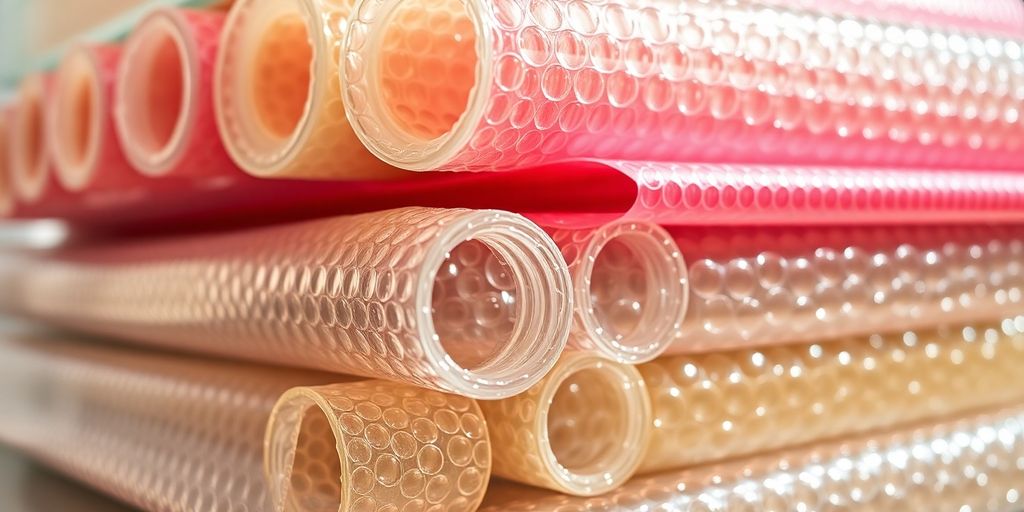Ever thought about what keeps your fragile items safe during shipping? Is those little packing styrofoam peanuts! They’re the unsung heroes of the shipping world, quietly doing their job to make sure everything arrives in one piece.
Whether it’s a delicate vase or an oddly shaped gadget, these peanuts fill the gaps, offering cushioning and protection. Sure, they might not be the most glamorous packing material out there, but they sure are effective. Let’s take a closer look at these handy little helpers and see why they’re so important in the shipping industry.
The Role of Packing Styrofoam Peanuts in Modern Shipping, what are styrofoam peanuts made of
 Understanding the Composition of Packing Styrofoam Peanuts
Understanding the Composition of Packing Styrofoam Peanuts
Packing styrofoam peanuts, also known as:
- foam peanuts edible
- or loose fill, are made from:
- expanded polystyrene (EPS) and after product exit polystyrene peanuts UK
- or bio-degradable materials like cornstarch. These raw materials make them:
- lightweight
- and able to conform to the shape of the item being shipped.
How Packing Styrofoam Peanuts Provide Protection
Packing peanuts UK are not just fillers; they are critical in safeguarding items during transit. Their unique ability to fill:
- voids
- and conform to the shape of the product ensures minimal movement, reducing the risk of damage from impacts. This makes them ideal for protecting fragile items.
The adaptable of Packing Styrofoam Peanuts, what are packing peanuts made of
Packaging peanuts are incredibly versatile. They can be used by storage with movers for a variety of items:
- from delicate glassware
- to sturdy electronics. Their lightweight nature means they don’t significantly add to shipping costs. Moreover, they can be:
- reused multiple times, making them a cost-effective solution for many businesses.
Environmental Impact of Packing Styrofoam Peanuts
 Biodegradable packing chips alternatives to Traditional Packing Peanuts
Biodegradable packing chips alternatives to Traditional Packing Peanuts
Switching to biodegradable packing peanuts is a smart move for anyone looking to reduce their environmental footprint. Unlike traditional styrofoam peanuts, these eco-friendly options break down naturally. They’re typically made from renewable resources like:
- cornstarch, making them a more sustainable choice. You can even dissolve some types in water, which is pretty neat and reduces landfill waste.
Recycling and Disposal of Packing Styrofoam Peanuts
Packing peanuts, especially the biodegradable kind, offer more straightforward disposal options. You can often compost biodegradable styrofoam peanuts or simply dissolve them in water. For the traditional ones, many shipping stores accept them for recycling.
Viable Practises in the Packaging Industry
The packaging industry is slowly shifting towards more sustainable practises:
- biodegradable and compostable packing is a part of this change. Companies are exploring new materials and methods to lessen their environmental impact. By choosing biodegradable packing peanuts, businesses not only protect their goods but also show a commitment to the planet. Is all about finding that balance between functionality and viable.
The shift towards biodegradable packing peanuts is not just about reducing waste; it’s about embracing a more sustainable future.
Comparing Packing Styrofoam Peanuts with Other Packaging Materials
Packing Styrofoam Peanuts vs Bubble Wrap
When need to protecting fragile items, both packing peanuts and bubble wrap are popular choices. Packing peanuts offer superior cushioning by filling voids completely, which helps prevent items from shifting during transit. Bubble wrap, on the other hand, provides a snug wrap around objects, offering direct impact protection .
Advantages of Packing Styrofoam Peanuts Over Foam Sheets
Packing peanuts are incredibly lightweight, which is a significant advantage over foam sheets. Foam sheets can add weight to packages, potentially increasing shipping costs. Furthermore, peanuts are more versatile, eco friendly packaging ; they can conform to:
- the shape of any item, providing a custom fit that foam sheets cannot match. Foam sheets, while offering a smooth surface for delicate items, lack the flexibility and flexible of packing peanuts.
When to Choose Packing Styrofoam Peanuts
Not for packing noodles or packing nuts, choosing packing peanuts is ideal when:
- shipping a variety of items in a single package. Their ability to fill:
- every nook or corn starch
- and cranny ensures that each item is cushioned and protected. They are especially useful for:
- special shaped items
- or when multiple items need to be packed together. Opt for packing peanuts when:
- lightweight, versatile, and effective void-fill is required to ensure items arrive safely.
Best Practises for Using Packing Styrofoam Peanuts
Proper Layering Techniques with Packing Styrofoam Peanuts
To make sure your items arrive safely, layering is key when using packing styrofoam peanuts. Start by pouring a layer of peanuts at the bottom of the box.
Place your item in the centre, then fill the sides with more peanuts. Finish with a top layer to ensure the item is completely cushioned.
Securing Packages with Packing Styrofoam Peanuts
Once your item is snugly packed with peanuts, close the box and secure it with strong tape. Give the box a gentle shake to check if anything moves inside. If it does, add more peanuts until everything is firm. This step is essential to prevent any damage during shipping.
Labelling and Handling Packages with Packing Styrofoam Peanuts
After packing, label the moving box as “Fragile”. This alerts handlers to be cautious with the package. Is a simple step but crucial for the safety of your shipment. Proper labelling ensures that everyone handling the package knows it contains delicate items that need extra care.
Cost-Effectiveness of Packing Styrofoam Peanuts
How Packing Styrofoam Peanuts Reduce Shipping Costs
Packing styrofoam peanuts are incredibly lightweight, which means they don’t add much to the overall weight of a package. Whether you’re shipping across the country or just a few towns over, keeping the weight down can save you a bunch of money.
The Economic Benefits of Lightweight Packing Materials
When you’re trying to keep your shipping budget in check, every little bit helps. Lightweight materials like packing peanuts are not just about cutting costs on postage. They also reduce the need for additional protective layers, meaning you can use smaller boxes or fewer materials overall. This adds to significant savings, especially for businesses that ship a lot of products.
Cost Comparison with Other Packaging Solutions
Here’s a simple comparison:
| Packaging Material | Average Cost per Cubic Foot | Weight Impact on Shipping |
|---|---|---|
| Packing Styrofoam Peanuts | Low | Minimal |
| Bubble Wrap | Medium | Moderate |
| Foam Sheets | High | High |
Packing peanuts often come out on top because they offer a balance of cost and protection. While bubble wrap and foam sheets have their perks, they tend:
- to be pricier
- and can add more weight, which might not be ideal for every shipment.
Innovations in Packing Styrofoam Peanuts
New Developments in Biodegradable Packing Peanuts
Biodegradable packing peanuts have been a game changer in the packaging industry. They dissolve in water, making them an eco-friendly alternative to polystyrene foam peanuts. Companies are improving these materials to enhance their durability while maintaining environmental benefits.
Technological Advances in Packing Material Production
Recent technological innovations have led to more efficient production processes for packing chips. These advancements focus on reducing energy consumption and waste during manufacturing. The introduction of automated systems has streamlined the production of both:
- traditional
- and 100 biodegradable foam peanuts, ensuring consistency in quality and performance for protective packaging
Future Trends in Packing Styrofoam Peanuts
Looking ahead, the focus is on developing dissolvable packing peanuts that offer:
- the same protective qualities as traditional ones but with a reduced environmental footprint. Researchers are exploring new materials that are not only biodegradable but also edible, opening possibilities for reducing waste in packaging.
- As the demand for sustainable solutions grows, the packaging industry is set to see more innovations that:
- balance protection
- and eco-friendliness.
The History and Evolution
Origins of Packing Styrofoam Peanuts
Packing peanuts, those lightweight and oddly shaped bits of foam, have been around for a while. They first appeared in the packaging world in the 1960s. Back then, they were made from expanded polystyrene, a kind of plastic that was:
- both cheap
- and easy to produce.
These little foam peanuts were a game-changer, allowing shippers to protect fragile items without adding much weight. They quickly became the go-to choice for cushioning goods in transit.
Key Milestones in Packing Peanuts Development
Over the years, packing peanuts have seen several changes. In the 1990s, the environmental impact of polystyrene became a hot topic, leading to the development of biodegradable alternatives. These new peanuts, often made from cornstarch, offered similar protective qualities without the environmental baggage. Here’s a quick look at some key milestones:
- 1960s: Introduction of polystyrene packing peanuts.
- 1990s: Development of biodegradable peanuts.
- 2000s: Advances in production technology, making them even more efficient.
The Future of Packing Styrofoam Peanuts
Looking ahead, the future of packing peanuts seems to be leaning towards eco-friendly. With growing awareness about environmental issues, companies are investing in research to make foam peanuts even more eco-friendly. Innovations in materials and production methods are likely to continue.
Conclusion
In the end, packing styrofoam peanuts might not be the first thing you think of when need to shipping, but they sure do their job well. These little guys fill up the spaces in boxes, making sure your stuff doesn’t:
- move around
- and get damaged.
They’re lightweight, so they don’t add much to shipping costs, and they can be used for all sorts of things:
- from glassware
- to electronics. Plus, with biodegradable options now available, they’re not as bad for the environment as they used to be.
FAQ(Frequently Asked Questions)
What are packing styrofoam peanuts?
Packing styrofoam peanuts are small, lightweight pieces made from expanded polystyrene or biodegradable materials.
How do packing styrofoam peanuts protect my items?
Packing styrofoam peanuts cushion items by filling gaps in the packaging, preventing movement and absorbing shocks during transit.
Are packing styrofoam peanuts environmentally friendly?
Traditional packing styrofoam peanuts are not bio-degradable. but there are eco-friendly options made from materials like cornstarch that break down more easily.
Can I recycle packing styrofoam peanuts?
Yes, many shipping companies and packaging stores offer recycling programmes for packing styrofoam peanuts. You can also reuse them for your own packaging needs.
When should I use packing styrofoam peanuts instead of bubble wrap?
Packing styrofoam peanuts are ideal for:
- filling large voids
- and protecting non-uniform shaped items, while bubble wrap is better for wrapping and cushioning smaller, more delicate items.
How do I properly use packing styrofoam peanuts in a package?
To use packing styrofoam peanuts, place a layer at the bottom of the box. add your item, and fill the remaining space with more peanuts. Ensure the item is snug and cannot move around.

 Understanding the Composition of Packing Styrofoam Peanuts
Understanding the Composition of Packing Styrofoam Peanuts Biodegradable packing chips alternatives to Traditional Packing Peanuts
Biodegradable packing chips alternatives to Traditional Packing Peanuts


